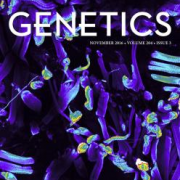Causal mutations for two guppy color variants identified
by Kottler et al.
Published in Genetics on May 11, 2013, by Kottler et al.:
Pigment pattern formation in the guppy, Poecilia reticulata, involves the Kita and Csf1ra receptor tyrosine kinases.
 Males of the guppy (Poecilia reticulata) vary tremendously in their ornamental patterns, which are thought to have evolved in response to a complex interplay between natural and sexual selection. Although the selection pressures acting onthe color patterns of the guppy have been extensively studied, little is known about the genes that control their ontogeny. Over 50 years ago, two autosomal color loci, blue and golden, have been described, which both play a decisive role in the formation of the guppy color pattern. Orange pigmentation is absent in the skin of guppies with a lesion in blue, suggesting a defect in xanthophore development. In golden mutants, the development of the melanophore pattern during embryo-genesis and after birth is affected. Here, we show that blue and golden correspond to guppy orthologs of colony-stimulating factor 1 receptor a (csf1ra;previously called fms) and kita. Most excitingly, we found that both genes are required for the development of the black ornaments of guppy males, which in thecase of csf1ra might be mediated by xanthophore-melanophore interactions. Furthermore, we provide evidence that two temporally and genetically distinct melanophore populations contribute to the adult camouflage pattern expressed in both sexes: one early-appearing and kita-dependent, and the other late-developing and kita-independent. The identification of csf1ra and kita mutants provides thefirst molecular insights into pigment pattern formation in this important model species for ecological and evolutionary genetics.
Males of the guppy (Poecilia reticulata) vary tremendously in their ornamental patterns, which are thought to have evolved in response to a complex interplay between natural and sexual selection. Although the selection pressures acting onthe color patterns of the guppy have been extensively studied, little is known about the genes that control their ontogeny. Over 50 years ago, two autosomal color loci, blue and golden, have been described, which both play a decisive role in the formation of the guppy color pattern. Orange pigmentation is absent in the skin of guppies with a lesion in blue, suggesting a defect in xanthophore development. In golden mutants, the development of the melanophore pattern during embryo-genesis and after birth is affected. Here, we show that blue and golden correspond to guppy orthologs of colony-stimulating factor 1 receptor a (csf1ra;previously called fms) and kita. Most excitingly, we found that both genes are required for the development of the black ornaments of guppy males, which in thecase of csf1ra might be mediated by xanthophore-melanophore interactions. Furthermore, we provide evidence that two temporally and genetically distinct melanophore populations contribute to the adult camouflage pattern expressed in both sexes: one early-appearing and kita-dependent, and the other late-developing and kita-independent. The identification of csf1ra and kita mutants provides thefirst molecular insights into pigment pattern formation in this important model species for ecological and evolutionary genetics.



